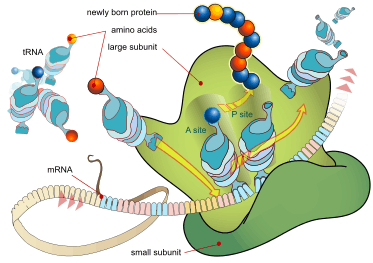Protein synthesis inhibitor

A protein synthesis inhibitor is a substance that stops or slows the growth or proliferation of cells by disrupting the processes that lead directly to the generation of new proteins.[1]
While a broad interpretation of this definition could be used to describe nearly any antibiotic, in practice, it usually refers to substances that act at the ribosome level (either the ribosome itself or the translation factor),[2] taking advantages of the major differences between prokaryotic and eukaryotic ribosome structures.
Toxins such as ricin also function via protein synthesis inhibition.[3] Ricin acts at the eukaryotic 60S.[4]
Examples:
Mechanism
In general, protein synthesis inhibitors work at different stages of prokaryotic mRNA translation into proteins, like initiation, elongation (including aminoacyl tRNA entry, proofreading, peptidyl transfer, and ribosomal translocation) and termination:
Earlier stages
- Rifamycin inhibits prokaryotic DNA transcription into mRNA by inhibiting DNA-dependent RNA polymerase by binding its beta-subunit.
Initiation
- Linezolid acts at the initiation stage,[5] probably by preventing the formation of the initiation complex, although the mechanism is not fully understood.[6]
Aminoacyl tRNA entry
- Tetracyclines and Tigecycline[7] (a glycylcycline related to tetracyclines) block the A site on the ribosome, preventing the binding of aminoacyl tRNAs.
Proofreading
- Aminoglycosides, among other potential mechanisms of action, interfere with the proofreading process, causing increased rate of error in synthesis with premature termination.[8]
Peptidyl transfer
- Chloramphenicol blocks the peptidyl transfer step of elongation on the 50S ribosomal subunit in both bacteria and mitochondria.
- Macrolides (as well as inhibiting ribosomal translocation[9] and other potential mechanisms) bind to the 50s ribosomal subunits, inhibiting peptidyl transfer.
- Quinupristin/dalfopristin act synergistically, with dalfopristin, enhancing the binding of quinupristin, as well as inhibiting peptidyl transfer.[10] Quinupristin binds to a nearby site on the 50S ribosomal subunit and prevents elongation of the polypeptide,[10] as well as causing incomplete chains to be released.[10]
Ribosomal translocation
- Macrolides,[9] clindamycin[11] and aminoglycosides[8] (with all these three having other potential mechanisms of action as well), have evidence of inhibition of ribosomal translocation.
- Fusidic acid prevents the turnover of elongation factor G (EF-G) from the ribosome.
Termination
- Macrolides[12][13] and clindamycin[12][13] (both also having other potential mechanisms) cause premature dissociation of the peptidyl-tRNA from the ribosome.
- Puromycin has a structure similar to that of the tyrosinyl aminoacyl-tRNA. Thus, it binds to the ribosomal A site and participates in peptide bond formation, producing peptidyl-puromycin. However, it does not engage in translocation and quickly dissociates from the ribosome, causing a premature termination of polypeptide synthesis.
- Streptogramins also cause premature release of the peptide chain.[14]
Protein synthesis inhibitors of unspecified mechanism
Binding site
The following antibiotics bind to the 30S subunit of the ribosome:
The following antibiotics bind to the 50S ribosomal subunit:
- Chloramphenicol[14]
- Erythromycin[14]
- Clindamycin[14]
- Linezolid[14] (an oxazolidinone)
- Telithromycin[14]
- Streptogramins[14]
- Retapamulin[15]
See also
References
- ↑ "Definition: protein synthesis inhibitor from Online Medical Dictionary".
- ↑ "7.344 Antibiotics, Toxins, and Protein Engineering, Spring 2007". MIT OpenCourseWare.
- ↑ Leonard JE, Grothaus CD, Taetle R (October 1988). "Ricin binding and protein synthesis inhibition in human hematopoietic cell lines". Blood. 72 (4): 1357–1363. PMID 3167211.
- ↑ Terao K, Uchiumi T, Endo Y, Ogata K (June 1988). "Ricin and alpha-sarcin alter the conformation of 60S ribosomal subunits at neighboring but different sites". Eur. J. Biochem. 174 (3): 459–463. doi:10.1111/j.1432-1033.1988.tb14120.x. PMID 3391162.
- ↑ Swaney SM, Aoki H, Ganoza MC, Shinabarger DL (December 1998). "The Oxazolidinone Linezolid Inhibits Initiation of Protein Synthesis in Bacteria". Antimicrob. Agents Chemother. 42 (12): 3251–3255. PMC 106030
 . PMID 9835522.
. PMID 9835522. - ↑ Skripkin E, McConnell TS, DeVito J, et al. (October 2008). "Rχ-01, a New Family of Oxazolidinones That Overcome Ribosome-Based Linezolid Resistance". Antimicrobial Agents and Chemotherapy. 52 (10): 3550–3557. doi:10.1128/AAC.01193-07. PMC 2565890
 . PMID 18663023.
. PMID 18663023. - ↑ Slover CM, Rodvold KA, Danziger LH (June 2007). "Tigecycline: a novel broad-spectrum antimicrobial". Ann Pharmacother. 41 (6): 965–972. doi:10.1345/aph.1H543. PMID 17519296. Retrieved 2009-12-19.
- 1 2 Flavio Guzmán (12/08/2008). "Protein synthesis inhibitors: aminoglycosides mechanism of action animation. Classification of agents". Pharmamotion. Check date values in:
|date=(help) - 1 2 Protein synthesis inhibitors: macrolides mechanism of action animation. Classification of agents Pharmamotion. Author: Gary Kaiser. The Community College of Baltimore County. Retrieved on July 31, 2009
- 1 2 3 Page 212 in: Title: Hugo and Russell's pharmaceutical microbiology Authors: William Barry Hugo, Stephen P. Denyer, Norman A. Hodges, Sean P. Gorman Edition: 7, illustrated Publisher: Wiley-Blackwell, 2004 ISBN 0-632-06467-6 Length: 481 pages
- ↑ Wisteria Lane cases --> CLINDAMYCIN University of Michigan. Retrieved on July 31, 2009
- 1 2 Menninger JR (1995). "Mechanism of inhibition of protein synthesis by macrolide and lincosamide antibiotics". J Basic Clin Physiol Pharmacol. 6 (3–4): 229–250. doi:10.1515/JBCPP.1995.6.3-4.229. PMID 8852269.
- 1 2 Tenson T, Lovmar M, Ehrenberg M (July 2003). "The mechanism of action of macrolides, lincosamides and streptogramin B reveals the nascent peptide exit path in the ribosome". J. Mol. Biol. 330 (5): 1005–1014. doi:10.1016/S0022-2836(03)00662-4. PMID 12860123.
- 1 2 3 4 5 6 7 8 9 Levinson, Warren (2008). Review of medical microbiology and immunology. New York: McGraw-Hill Medical. ISBN 978-0-07-149620-9.
- 1 2 Drugbank.ca > Showing drug card for Retapamulin (DB01256) Update Date: 2009-06-23